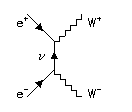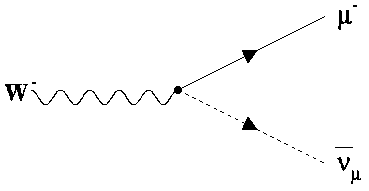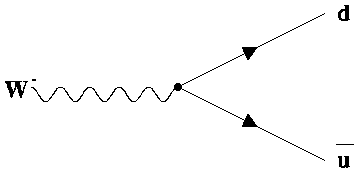How to Identify Events Containing a Pair of W Particles
The production of a \(W^{+}W^{-}\) pair of particles can be represented by the following diagrams:


After about 10-25 seconds a \(W\) decays, so we don't see it directly in our detector. A \(W\) can decay in two different ways. The first type of decay produces a lepton and an antineutrino. For example, the following picture shows the \(W^{-}\) decaying to a muon (\(\mu^{-}\)) and a muon antineutrino (\(\bar{\nu}_{\mu}\)).

In a similar way a \(W\) can to decay to produce an electron (\(e\)) or a tau lepton (\(\tau\)).
The second type of \(W\) decay produces a quark and an antiquark:

Because both the \(W^{+}\) and the \(W^{-}\) decay to produce particles we see in the detector, the resulting events are slightly more complicated than the particle-antiparticle pair events we looked at in the previous section. We get different types of \(W^{+}W^{-}\) event depending on whether both \(W^{+}\) and \(W^{-}\) decay to produce quarks, both decay to produce leptons, or one \(W\) decays to produce quarks and one \(W\) decays to produce leptons.
Below are some examples of the different types of \(W^{+}W^{-}\) events.
Both \(W^{+}\) and \(W^{-}\) decay to produce a quark and an antiquark:
Both \(W^{+}\) and \(W^{-}\) decay to produce a charged lepton and a neutrino:
One \(W\) decays to produce a charged lepton and a neutrino, and the other \(W\) decays to produce a quark and an antiquark: